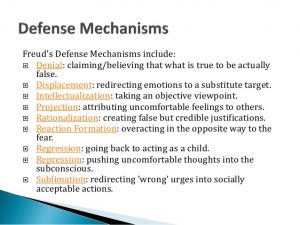Psychology Notes On – Types And Examples Of Defense Mechanisms – For W.B.C.S. Examination.
Sigmund Freud (1894, 1896) noted a number of ego defenses which he refers to throughout his written works. His daughter Anna Freud (1936) developed these ideas and elaborated on them, adding ten of her own. Many psychoanalysts have also added further types of ego defenses.Continue Reading Psychology Notes On – Types And Examples Of Defense Mechanisms – For W.B.C.S. Examination.
We use defense mechanisms to protect ourselves from feelings of anxiety or guilt, which arise because we feel threatened, or because our id or superego becomes too demanding.
Defense mechanisms operate at an unconscious level and help ward off unpleasant feelings (i.e., anxiety) or make good things feel better for the individual.
Ego-defense mechanisms are natural and normal. When they get out of proportion (i.e., used with frequency), neuroses develop, such as anxiety states, phobias, obsessions, or hysteria.
Some of the major defense mechanisms described by psychoanalysts are the following:
-
1. Repression is the withdrawal from consciousness of an unwanted idea, affect, or desire by pushing it down, or repressing it, into the unconscious part of the mind. An example may be found in a case of hysterical amnesia, in which the victim has performed or witnessed some disturbing act and then completely forgotten the act itself and the circumstances surrounding it.
-
2. Reaction formation is the fixation in consciousness of an idea, affect, or desire that is opposite to a feared unconscious impulse. A mother who bears an unwanted child, for example, may react to her feelings of guilt for not wanting the child by becoming extremely solicitous and overprotective to convince both the child and herself that she is a good mother.
-
3. Projection is a form of defense in which unwanted feelings are displaced onto another person, where they then appear as a threat from the external world. A common form of projection occurs when an individual, threatened by his own angry feelings, accuses another of harbouring hostile thoughts.
-
4. Regression is a return to earlier stages of development and abandoned forms of gratification belonging to them, prompted by dangers or conflicts arising at one of the later stages. A young wife, for example, might retreat to the security of her parents’ home after her first quarrel with her husband.
-
5. Sublimation is the diversion or deflection of instinctual drives, usually sexual ones, into noninstinctual channels. Psychoanalytic theory holds that the energy invested in sexual impulses can be shifted to the pursuit of more acceptable and even socially valuable achievements, such as artistic or scientific endeavours.
-
6. Denial is the conscious refusal to perceive that painful facts exist. In denying latent feelings of homosexuality or hostility, or mental defects in one’s child, an individual can escape intolerable thoughts, feelings, or events.
-
7. Rationalization is the substitution of a safe and reasonable explanation for the true (but threatening) cause of behaviour.
Psychoanalysts emphasize that the use of a defense mechanism is a normal part of personality function and not in and of itself a sign of psychological disorder. Various psychological disorders, however, can be characterized by an excessive or rigid use of these defenses.
Please subscribe here to get all future updates on this post/page/category/website


 +919674493673
+919674493673  mailus@wbcsmadeeasy.in
mailus@wbcsmadeeasy.in







































































































